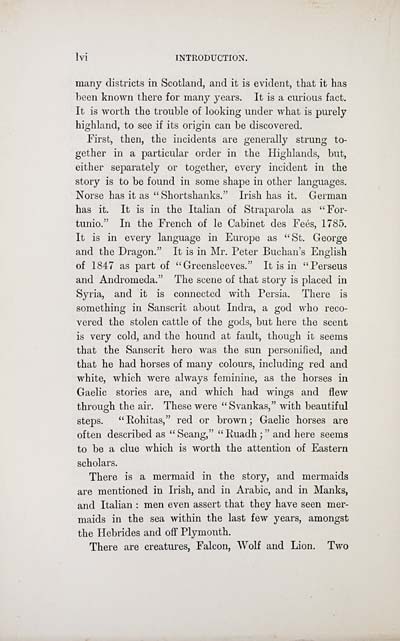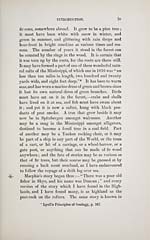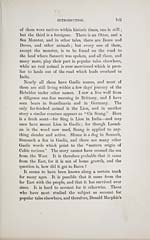Download files
Complete book:
Individual page:
Thumbnail gallery: Grid view | List view

Ivi INTRODUCTION.
many districts in Scotland, and it is evident, that it has
been known there for many years. It is a curious fact.
It is worth the trouble of looking under what is purely
highland, to see if its origin can be discovered.
First, then, the incidents are generally strung to-
gether in a particular order in the Highlands, but,
either separately or together, every incident in the
story is to be found in some shape in other languages.
Norse has it as " Shortshanks." Irish has it. German
has it. It is in the Italian of Straparola as "For-
tunio." In the French of le Cabinet des Fees, 1785.
It is in every language in Europe as "St. George
and the Dragon." It is in Mr. Peter Buchan's English
of 1847 as part of " Greensleeves." It is in "Perseus
and Andromeda." The scene of that story is placed in
Syria, and it is connected with Persia. There is
something in Sanscrit about Indra, a god who reco-
vered the stolen cattle of the gods, but here the scent
is very cold, and the hound at fault, though it seems
that the Sanscrit hero was the sun personified, and
that he had horses of many colours, including red and
white, which were always feminine, as the horses in
Gaelic stories are, and which had wings and flew
through the air. These were "Svankas," with beautiful
steps. " Rohitas," red or brown ; Gaelic horses are
often described as "Seang," "Kuadh;" and here seems
to be a clue which is worth the attention of Eastern
scholars.
There is a mermaid in the story, and mermaids
are mentioned in Irish, and in Arabic, and in Manks,
and Italian : men even assert that they have seen mer-
maids in the sea within the last few years, amongst
the Hebrides and off Plymouth.
There are creatm-es, Falcon, Wolf and Lion. Two
many districts in Scotland, and it is evident, that it has
been known there for many years. It is a curious fact.
It is worth the trouble of looking under what is purely
highland, to see if its origin can be discovered.
First, then, the incidents are generally strung to-
gether in a particular order in the Highlands, but,
either separately or together, every incident in the
story is to be found in some shape in other languages.
Norse has it as " Shortshanks." Irish has it. German
has it. It is in the Italian of Straparola as "For-
tunio." In the French of le Cabinet des Fees, 1785.
It is in every language in Europe as "St. George
and the Dragon." It is in Mr. Peter Buchan's English
of 1847 as part of " Greensleeves." It is in "Perseus
and Andromeda." The scene of that story is placed in
Syria, and it is connected with Persia. There is
something in Sanscrit about Indra, a god who reco-
vered the stolen cattle of the gods, but here the scent
is very cold, and the hound at fault, though it seems
that the Sanscrit hero was the sun personified, and
that he had horses of many colours, including red and
white, which were always feminine, as the horses in
Gaelic stories are, and which had wings and flew
through the air. These were "Svankas," with beautiful
steps. " Rohitas," red or brown ; Gaelic horses are
often described as "Seang," "Kuadh;" and here seems
to be a clue which is worth the attention of Eastern
scholars.
There is a mermaid in the story, and mermaids
are mentioned in Irish, and in Arabic, and in Manks,
and Italian : men even assert that they have seen mer-
maids in the sea within the last few years, amongst
the Hebrides and off Plymouth.
There are creatm-es, Falcon, Wolf and Lion. Two
Set display mode to: Large image | Transcription
Images and transcriptions on this page, including medium image downloads, may be used under the Creative Commons Attribution 4.0 International Licence unless otherwise stated. ![]()
| Early Gaelic Book Collections > Matheson Collection > Popular tales of the west Highlands > Volume 1 > (76) |
|---|
| Permanent URL | https://digital.nls.uk/81388140 |
|---|
| Description | Volume I. |
|---|---|
| Shelfmark | Mat.74 |
| Additional NLS resources: | |
| Attribution and copyright: |
|
| Description | Items from a collection of 170 volumes relating to Gaelic matters. Mainly philological works in the Celtic and some non-Celtic languages. Some books extensively annotated by Angus Matheson, the first Professor of Celtic at Glasgow University. |
|---|
| Description | Selected items from five 'Special and Named Printed Collections'. Includes books in Gaelic and other Celtic languages, works about the Gaels, their languages, literature, culture and history. |
|---|

